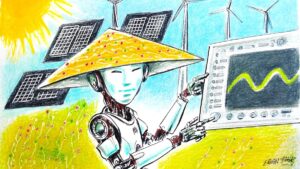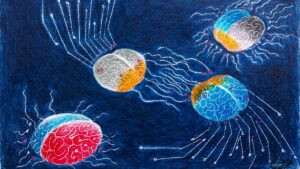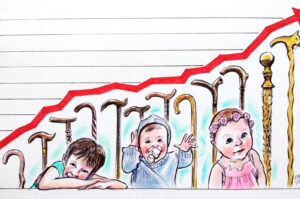The development of technology today has gained an unprecedented momentum compared to previous centuries. Moreover, not only the technological advancements themselves but also the spread of these technologies in human life has accelerated, encompassing almost every aspect of daily life. It has now become quite challenging to sustain life without utilizing technology. In particular, the use of social media has started to replace face-to-face communication. As a result, while generational distinctions in the past were primarily related to age, these distinctions are now more closely associated with technological literacy.
Machine learning, deep learning and artificial intelligence technologies have become indispensable components of digital platforms. Thanks to these technologies, digital platforms have evolved into structures capable of understanding personal needs and offering tailored solutions for them. The ability to provide personalized solutions and recommendations has elevated technology to an even more indispensable position for individuals. As technology becomes smarter and continuously learns, the human-machine relationship has transitioned to a different phase and continues to do so at an accelerating pace. The smarter technology becomes, the less it allows humans to disconnect (go offline). It demands that people spend all their time online. However, what is presented as the natural outcome of a process has gone far beyond being a matter of democratic choice. The possibilities afforded by leveraging billions of personal data points have transformed staying online from a choice into a mandatory dependency. To this end, all neurochemical mechanisms of addiction are utilized, and scientific findings are effectively mobilized to achieve this goal.
The increasing data processing capacity of technology, enabling it to offer personalized solutions and recommendations, significantly deepens its sphere of influence by adopting an individualized approach. Through adaptive algorithms, the data of each individual is continuously analyzed, exposing them to specific content and extending their online activity duration. In this way, a mechanism is established that perpetually nurtures individual interest. The strength of this chain can be illustrated as follows: as individuals encounter content they are interested in, their usage time increases; as they use these platforms, data processing mechanisms collect more data about them and provide even more tailored content. This creates a self-reinforcing cycle that continuously feeds itself and deepens dependency. As a result, the likelihood of individuals escaping the “personalized” traps designed specifically for them within this cycle becomes increasingly slim.
Perhaps, for the first time in history, humanity is being rendered so helpless. This situation creates its own paradox: humanity becomes dependent on the very technology it has developed and can no longer detach itself from it. A small minority that produces this technology and collects all human data treats humanity as “experimental subjects.” In other words, technology is being used by those who develop and control it as a tool to manipulate human behavior. Humanity itself has now become the product. To the extent that an “attention-based economy business model” has been constructed, aimed at conditioning and capturing people’s attention.
At this point, digital platforms are fragmenting and polarizing societies by emphasizing their differences in ways that were unimaginable in the past. The information and content produced by polarized groups are specifically tailored to each polarized ecosystem. As a result, the paths of people clustered in different poles never intersect – or are deliberately prevented from intersecting. In other words, people are grouped based on their thoughts, behaviors, and attitudes, and the same information, recommendations and directives are repeatedly presented to these clustered groups.
Written, visual media, and communication channels are also being restructured according to the ecosystems of polarized groups, telling their audiences stories – often fictional – that they would enjoy seeing, hearing, and reading. In other words, a single news item, event, or incident is presented with as many different narratives as there are polarized factions in society. As a result, people end up following separate, homogenized TV channels and newspapers that exclude diverse voices, reinforcing their existing perspectives.
On the other hand, advancing technology makes it easier to filter content, allowing people to receive pre-selected information more readily. This prevents different and surprising news from entering echo chambers. These processes occur in most countries indicates that this is a global phenomenon. This not only sustains echo chambers populated by groups of people who can only tolerate hearing their own voices, but also accelerates the spread of manipulative and false news and information between opposing sides. A recent comprehensive studies show that false news spreads much faster, broader, and deeper online than truthful information. While distortion, exaggeration, and fabricated news have existed in the past, they were exceptions. Now, however, such practices have become widespread.
Monopolizing and constantly expanding platforms have now become a national security issue for many countries. The perception of these platforms as a threat to society and democracy has sparked debates, leading to discussions about how they can be controlled and various solutions being proposed. However, it seems unlikely that significant outcomes beyond short-term fixes will emerge, as the minority who own these massive monopolized technologies are unwilling to sacrifice their profits and advantages. At this point, the biggest challenge facing youth is becoming unknowingly trapped in technological addiction. The fact that most of these technologies are free and easily accessible today broadens the scope of addiction. The most significant threat lies in the deliberate reinforcement of the perception that such addictions are rare occurrences. As a result, families encountering addictive behaviors often believe that the problem is unique to their children. However, addiction is not an unintended or rare behavior in these technologies – it is a desired and engineered outcome. Far from being a phenomenon affecting only a small group, all individuals are under the same threat. Thus, these addictions are precisely the outcomes global technology producers desire. Observing the massive investments technology companies make in products they offer to end users for free or under extremely favorable conditions helps clarify the direction this process is heading.
In technological addictions, dependency manifests through behavioral patterns. Since internet and digital addictions do not involve the consumption of a tangible substance, as in substance addiction, they are often not recognized as addictions. Furthermore, the distinction between a user and an addict remains quite ambiguous. In other words, every addict is a user, but not every user is necessarily an addict. Addictions to these technologies develop over time rather than emerging suddenly, making the transition from user to addict difficult to detect.
The first casualty on the road to addiction is self-control. As the time spent online increases, self-control gradually begins to erode. The ability to manage time weakens progressively. Critical skills in daily life, such as focusing and deep thinking, also deteriorate over time. Individuals’ minds grow lazy, their capacity for reflection diminishes, and, moreover, their qualities as thinking and acting individuals are slowly lost. In all countries, generations are emerging that gradually lose connection with their cultural values and begin to act according to new behavioral patterns manipulated by online mechanisms. The commonalities in complaints about young people suggest that they are all exposed to the same processes.
Mechanisms such as acceptance, approval, and being valued are now increasingly reinforced in online environments, while feelings of trust and control are weakened, leaving individuals more susceptible to influence. Particularly among young people, the fear of being excluded often leads them to submit – sometimes reluctantly – to online mechanisms of approval, recognition and acceptance. As a result, although individuality is emphasized, they gradually lose their self-control. People’s emotions – happiness, sadness, anxiety, expectations and other states tied to pleasure – are increasingly driven not by the real world but by their interactions with the online world. Real relationships are being replaced by virtual ones.
The offline world is gradually losing its significance, and ultimately, individuals are left isolated in virtual environments. This state of loneliness and isolation makes individuals far more susceptible to manipulation. As time spent online continues to increase, the foundation for healthy relationships – starting with the family and extending to the broader social environment – is steadily eroded. All real-world relationships and social connections are being reconstructed through new connections and relationships formed in online virtual spaces. In every aspect of life, substitutes have been positioned as candidates to replace reality. In this process, the fabric, relationships, and common ground that allow values to thrive in the real world are being eradicated, paving the way for a new ecosystem to emerge. Unfortunately, this new ecosystem has no room for empathy, altruism or sharing in the struggles of others.




















































Be First to Comment